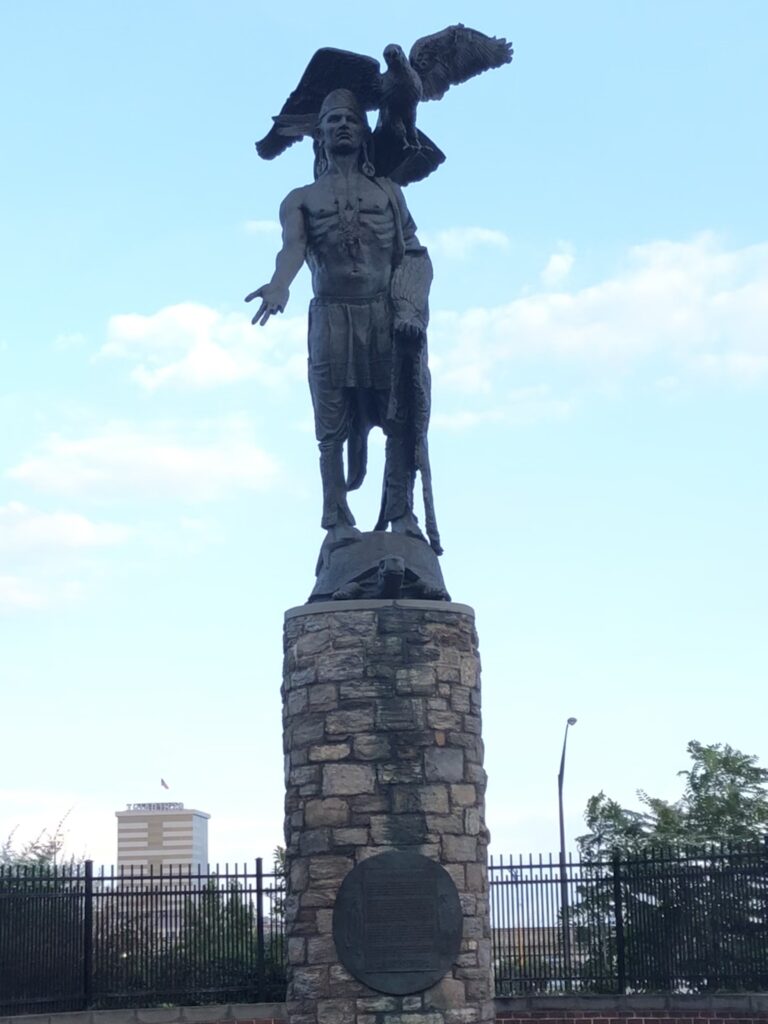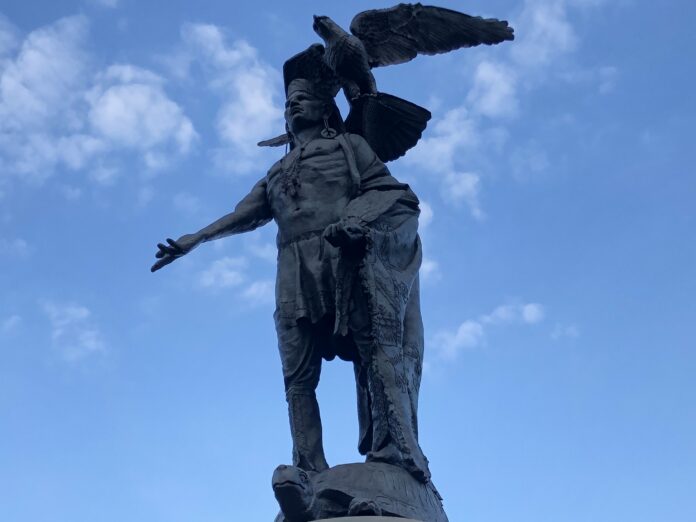In 1995 the City of Philadelphia unveiled artist Raymond Sandoval’s monumental bronze sculpture of Chief Tamanend at Penn’s Landing on Front and Market Streets. Tamanend is famous for signing the peace treaty with William Penn in 1683. About a year ago, after Sandoval came to visit Philly and noticed the sculpture was in need of some restoration as stipulated in the contract he entered with the city, the statue was professionally cleaned up and returned to its place of honor.
PGN sat down with Sandoval to talk about his work, his heritage, and how 16 generations coming before him have shaped his life and art.
So, how do you self-identify as a person of indigenous heritage, a gay man, and as an artist? Do you consider “Mestizo” a fair description of your ancestry related to the region?
Funny question about identity. I don’t label myself in any of those categories, with the exception of “artist.” As a kid growing up here in Jemez Springs, NM, population 210, with all races, black, white, native and Mexican, we went to school together, played at recess together. It wasn’t until I left Jemez Springs to live with my Dad in Albuquerque that I began to discover who I am. I never heard the word Mestizo, the word I heard was coyote. Meaning the same thing. I always felt proud of the fact that my great-grandmother was from Cochiti.
So, tell me your Philadelphia connection?
My Philadelphia connection starts in Albuquerque where I didn’t fit in. I decided after going out to the only gay bar in Albuquerque, being humiliated and laughed at, that I had to get away. The job I had at the time had an opening in Michigan. Two days later I packed a suitcase, got on Amtrak and left. While in Ann Arbor I got accepted into the University of Michigan Art School. I met David, a landscape architect. After the semester my professor told me about PAFA and in the summer I should visit. David had a job interview in Philly. We moved in the summer of 1982. After a year living in Philadelphia, working odd jobs, I gained residency and was accepted at the PAFA.
What was our gay community like back then?
David and I didn’t go out much. We met a few people and stayed away from clubs and bars. Our goal was to get out of our overpriced apartment. We found a house not far from school, work. It was cheap, and located at 16th and Fitzwater. There I spent all my free time demolishing walls, renovating that house. Then AIDS hit the USA. I remember a lot of friends died, tough times then. I survived AIDS. The gay community was angry. I remember the ACT UP protest down Broad street. It was a time of great sorrows.

How did you get the commission for the Chief Tamanend sculpture on Penn’s Landing?
The call for an artist to create Tamanend was in the local paper. They were redeveloping a section in Old City, Penn’s Landing. I applied and my proposal to put Tamanend at that spot was chosen. I felt proud I had been shortlisted from a group numbering 3,000 applicants.
Can you tell me about the process of creating the sculpture?
As a finalist you presented a maquette of the sculpture. After getting the commission I had to find a place to build a 23-foot sculpture. Lucky me: the house next to ours was bought by David and an investor. It was in this row house that we removed the floor beams from the first floor to the basement. Then the second floor beams were removed. I spent that year building an enormous armature to hold 5,000 lbs of water based clay.The waxes were shipped to Baltimore and the bronze was cast between 1994 and 1995.
You said as an artist it is important “you be yourself.” How do you merge the qualities of some of your work, such as the religious influence, the crucifix sculpture at your grandmother’s church, and Muertos images, while recognizing aspects of colonial history were detrimental to native society?
I have to be myself. I used to care what people thought of me and I would do or make art that was not me. As I have grown older I don’t care what people think and am free. I grew up going to church every Sunday, my Grandmother took me with her. No choice there. I am of two cultures. I had no choice in that. I was born gay. No choice in that. Going to church every Sunday as an adult grown man I had a choice. I have ties to the church from my youth. The crucifixion sculpture is a triumph, because the church chose my proposal because I know how to present myself, not because I’m gay, and not because I haven’t been to church in 30 years.
I saw the Muertos Erotica image. Can you tell me how that is both a celebration of and perhaps a deviation from the norms?
The Muertos work is a homage to my grandmother. In her bedroom she had her santo, her rosary, candles, small skeletons, and prayed every night. She taught me at a young age what Dia del los Muertos was and to honor the ancestors who created my life. It wasn’t voodoo or halloween: it’s this family history. My interpretation of Dia de los Muertos includes everyone, I had an Uncle who was killed in the 60’s because he was a drag queen. From that I decided to include gay images into Day of the Dead retablos.
Tell me more about “Send Her Back.” As a (lapsed) Catholic, art history guy, and pro-immigrant, I see the intent of the juxtaposition. But let’s get more of your context here.
“Send Her Back,” denounces the hate and mistreatment of immigrants. We who have family history here dating back 16 generations always say the border crossed us, we did not cross the border. Everyone who lives here was an immigrant at one time, except of course the Native people who were here. The painting has multiple meanings: outrage at the mistreatment of those wanting a better life, a loss of cultural identity, and this new cancel culture movement. I will offend anyone with the truth.
To learn more about Sandoval’s work, visit RaymondSandoval.com/.
